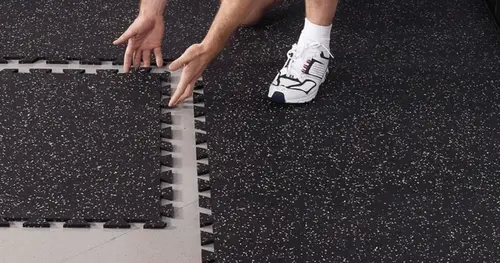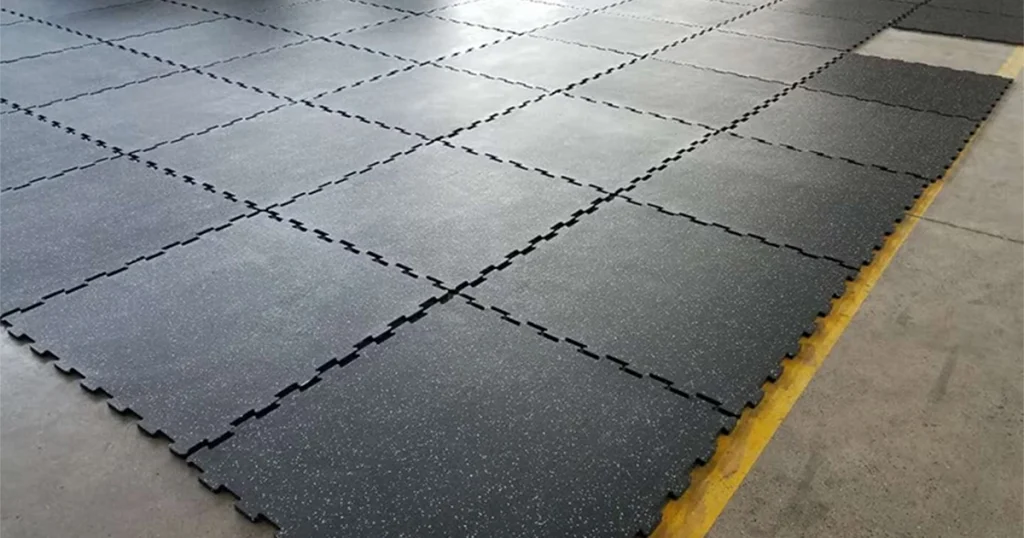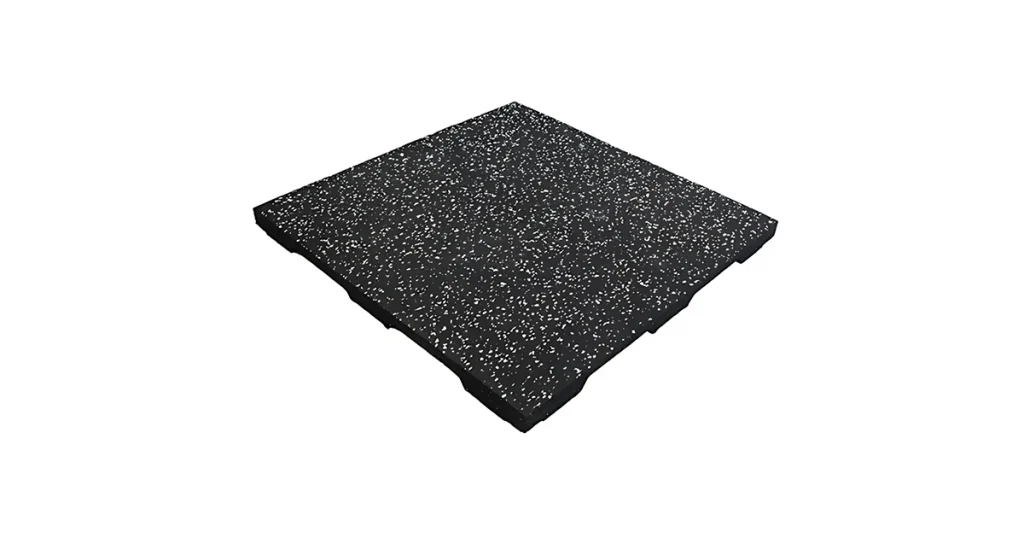Your cart is currently empty!

What to Look for in Gym Flooring for Heavy Weights

When you’re serious about training, bench pressing, deadlifting, doing virtual workouts via IFIT, preparing for marathons, or simply replacing your Peloton with a full studio-ready setup, the one thing many overlook is the solid foundation under your feet. Gym flooring for heavy weights isn’t just about looking good. It plays a critical role in safety, durability, and performance.
In this guide, we’ll walk you through: what you should check for, how to choose the best rubber gym flooring in Pakistan (and beyond), what makes one product better than another, and why choosing the right floor matters if you’re investing in serious strength training or cardio.
Why gym flooring for heavy weights matters
Many think flooring is aesthetic or optional, but when you drop heavy plates, push sleds, drag machines, or run 10,000+ virtual workouts with IFIT, the floor becomes part of the equipment. Here’s what good flooring supports:
- Protects your sub-floor (concrete slab, timber base) from damage by weights, racks, and machines.
- Absorbs shock to reduce joint stress, especially when dropping heavy barbells or plates.
- Minimises noise and vibration (important if your gym is above other rooms or near neighbours).
- Provides a stable, safe, non-slip surface for dynamic movement (deadlifts, lunges, sleds, sprint drills).
- Enhances longevity of equipment and of the floor itself, so you’re not replacing or repairing prematurely.
Because you’re dealing with heavy weights and serious workouts, you’ll want gym flooring that isn’t just “good enough” but designed for durability and performance.
What to look for: The key features of good gym flooring for heavy weights

Here are the most important criteria when choosing gym flooring for heavy weights:
1. Material & construction
Rubber is widely considered the top choice for strength zones. It offers durability, shock absorption, and high resilience.
Look for products using recycled rubber granules or virgin rubber. The rubber must be dense and resilient, not cheap foam or thin mats that will compress or tear under load.
2. Thickness / weight-bearing capacity
If you are lifting heavy, especially dropping plates or using a sled, you’ll need thicker flooring. Some guides suggest:
- Light use (cardio, machines) → 8 mm (approx ⅜″) or so.
- Moderate weight zones → ½″ (≈12-13 mm) or more.
- Heavy drop zones (Olympic lifts, heavy racks) → ¾″ (≈19-20 mm) or thicker.
So if you drop 20-30kg plates or more, or have a heavy rack, aim for heavy-duty flooring. You’ll see products like “20 mm interlock rubber tile,” which are ideal.
3. Shock-absorbent fitness flooring
This is important: the floor must absorb impact so the force doesn’t bounce back at you or transmit into your joints or sub-floor. A floor that’s too rigid or thin might crack, shift, or lead to discomfort.
4. Stability & non-slip surface
Even if the flooring is cushioned, it must not shift beneath your equipment or feet. It must lock together well (for interlock tiles) or be bonded well (for rolls). You want a stable base so your rack stays stationary and you don’t have unintended movement when lifting.
5. Durability & abrasion resistance
When you invest in flooring, you want it to last for years under heavy use. Look at material specs like tear strength, abrasion resistance. One review mentions that rubber floors with high tensile strength (200 PSI+) perform way better than foam (15-45 PSI).
6. Protection for equipment & sub-floor
If you’re working on concrete or above signage or residential floors, you need flooring that protects the surface underneath. It also protects your rack feet, machines, and plates from grit, moisture, or damage.
7. Noise/vibrations
Especially if your gym is in a shared building or above someone, the flooring should reduce noise from equipment drops or machines running. Rubber helps here.
8. Easy maintenance & cleanliness
Gyms get sweaty, heavy, dusty. You’ll want flooring that is easy to clean, doesn’t trap odors or bacteria, and stands up to cleaning protocols. Some cheaper mats will deteriorate because of poor maintenance design.
9. Installation & modularity
For many gym owners or home gym enthusiasts in Pakistan (or anywhere), the benefits of easier installation count. Interlocking rubber tiles are great because you can install them yourself, repair sections later, and expand. Rolls may require more professional effort.
10. Floor zone planning
If you’re outfitting a full gym or serious home setup, you might have separate zones: heavy weight zone (racks, deadlifts), cardio zone (treadmills, bikes), functional zone (sleds, agility), etc. Each may need different flooring. So choose a thicker rubber base for the weight zone; perhaps turf or thinner rubber for the sled zone.
Best rubber gym flooring Pakistan: What to check locally

If you are in Pakistan (or importing) and looking for the best rubber gym flooring in Pakistan, here are specific considerations:
- Ensure the supplier offers heavy-duty rubber interlocking tiles (10 mm, 20 mm thickness) or rubber rolls with high density. For example, products like “Rubber Tile Interlock 6mm”, “Rubber Tile Interlock 10mm”, and “Rubber Tile 20mm” are ideal.
- Check that the material is appropriate for heavy-weight training, not just light foam tiles. It must support racks, dropped plates, and machines.
- Ask for the impact/load rating, how much weight per square metre it can sustain without cracking or compressing.
- For shock-absorbent fitness flooring, make sure the rubber has proper “give” but is not so soft that your rack sinks or your barbell bounces up dangerously.
- Evaluate the sub-floor: In Lahore or other cities, often gyms are built over concrete slabs or above ground floors. Make sure the flooring and installation account for moisture (basements), temperature, and possible unevenness.
- Make sure you get edge finishing (so tiles don’t lift), a non-slip surface, and easy cleaning. Gyms see high foot traffic.
- Budget properly: While cheaper foam mats may cost less, they often fail early when heavy weights are dropped. It’s worth investing in proven rubber gym flooring for heavy-weight zones.
Check our commercial gym flooring options here.
Buying a table: Compare thickness and suitability
Here’s a quick reference table to help you decide what thickness and type you need when you’re selecting gym flooring for heavy weights:
| Thickness / Type | Best Use Case | Suitable For | Notes |
| ~6–8 mm rubber interlock | Light cardio area, machines, general fitness | Home gym, light free weights | Not ideal for heavy drops |
| ~10–12 mm rubber interlock | Moderate weight training, general strength zone | Commercial gym mid-weight zone | Good all-round choice |
| ~15–20 mm (or ~¾″) heavy rubber tile | Heavy racks, deadlift platforms, Olympic lifts | Serious strength zones, heavy weights | Best for gym flooring for heavy weights |
| Rubber roll sheets (ring drop zone) | Large area weight zone, continuous surface | High-traffic commercial gyms | Requires professional installation |
Use this table as a guide. If your gym features heavy-loaded bars, bumper plates, or frequent dropping of weights, aim for the thicker end.
How to install and maintain your gym flooring for heavy weights
Here are practical tips to get the most out of your gym flooring:
- Ensure the sub-floor is level, clean, and dry before installing rubber tiles or rolls. An uneven base will undermine performance.
- When using interlocking tiles, let them acclimate before heavy use. Some rubber floors can flatten or shift if weight is applied too soon.
- If your gym has multiple zones, use different flooring types but keep transitions safe (e.g., rubber-heavy zone to turf functional zone).
- Regularly clean the floor: sweep/vacuum dust and use a mild detergent or rubber-safe cleaner. Avoid harsh chemicals, which degrade rubber.
- Inspect periodically for compressed spots, tears, edges, liftinand g. Replace tiles or roll segments as needed.
- Use mats or platforms under racks or loaded drop zones if necessary for extra protection.
- Encourage proper gym etiquette: place bumper plates instead of metal plates when dropping; reposition racks rather than dragging heavy machines across the floor to avoid gouging the material.
Why Choose Vibe’s Commercial Gym Flooring Options
If you’re searching for reliable, long-lasting gym flooring for heavy weights in Pakistan, Vibe offers some of the best options available. Their collection includes rubber tile interlocks in 6 mm, 10 mm, and 20 mm thicknesses, allowing you to choose flooring that matches your workout intensity and training style.
The 20 mm rubber tile is especially built for heavy lifting and commercial gym environments, providing excellent durability, shock absorption, and stability under extreme loads. Each interlocking tile is designed for easy installation and replacement; you can swap out a damaged tile without removing the entire floor, saving both time and cost.
Whether you’re a runner using IFIT’s 10,000+ virtual workouts or someone transitioning from cardio to serious strength training, Vibe flooring provides the balance between endurance comfort and heavy-weight support. It ensures your training area performs as powerfully as your workouts.
You can purchase directly through Vibe or from Hadayat & Co., their trusted distributor in Pakistan, to get genuine, high-quality flooring delivered to your location.
Conclusion: The Foundation of Every Serious Workout
When setting up a gym, whether at home, in a studio, or in a commercial facility, the flooring isn’t just a detail. It’s the foundation of every movement, lift, and stride you take. Especially if you’re lifting heavy, preparing for marathons through IFIT’s virtual workouts, or replacing your Peloton-style setup with a complete strength and cardio space, the right gym flooring for heavy weights makes all the difference.
It protects your joints, your equipment, and your floor while giving you a stable, shock-absorbent base for every workout. Investing in durable, high-quality rubber flooring ensures your gym performs as hard as you do, session after session, year after year.
Get your Best gym flooring today.
FAQs
- What thickness is ideal for gym flooring for heavy weights?
A thickness of around 15-20 mm (or greater for very heavy loads) is ideal for zones where heavy weights are dropped and racks are anchored. Thinner flooring (6-8 mm) may work for cardio or lighter training. - Can I use foam tiles instead of rubber flooring for heavy lifting zones?
Foam tiles are more suited for low-impact areas like yoga or stretching. They compress easily and are not recommended for heavy-weight zones where rubber flooring is the better choice. - Is interlocking tile better than roll flooring for a home weightlifting gym?
Interlocking tiles are easier to install, repair, and change sections later. Rolls give a seamless surface but often require a professional install. For heavy-weight zones in a home gym, interlocking rubber tiles (thick enough) are a solid choice. - How do I clean and maintain rubber gym flooring to ensure it lasts?
Regularly sweep or vacuum to remove dust and debris. Use a mild detergent safe for rubber; avoid harsh chemicals or solvents. Check for damage, edges, and wear periodically. - Do I need different flooring for different zones (e.g., cardio vs weightlifting)?
Yes. It’s smart to use thicker, heavy-duty rubber in the weightlifting zone and perhaps a different surface (turf, thinner rubber) in cardio or functional training zones. This ensures each zone has flooring optimized for its demands.

